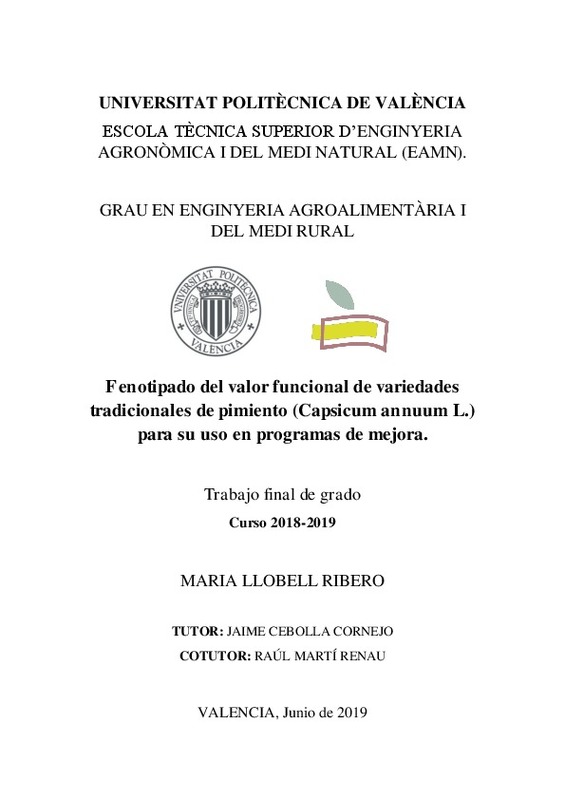|
Resumen:
|
[ES] El valor funcional de los alimentos es un parámetro que los consumidores tienen cada vez más en cuenta. Se trata de la capacidad de los alimentos para prevenir enfermedades. De esta forma, una dieta rica en compuestos ...[+]
[ES] El valor funcional de los alimentos es un parámetro que los consumidores tienen cada vez más en cuenta. Se trata de la capacidad de los alimentos para prevenir enfermedades. De esta forma, una dieta rica en compuestos bioactivos, puede contribuir a prevenir enfermedades degenerativas. El interés específico de los polifenoles radica en su capacidad para interferir con la iniciación, promoción y progreso de determinados tipos de cáncer.
En este contexto, un objetivo de mejora que se está consolidando en el mercado de semillas consiste en el aumento de los contenidos naturales de compuestos bioactivos. Para ello es necesario encontrar en primer lugar una fuente de variación. Es decir, identificar poblaciones que acumulen mayores niveles de un determinado compuestos. En el caso del pimiento, una parte importante del valor funcional viene determinada por la acumulación de polifenoles. Concretamente, la mayor parte se encuentra en forma de glucósidos de quercetina y luteolina.
Dentro de las variedades tradicionales encontramos los mayores niveles de variación de la especie cultivada. La identificación entre ellas de materiales con alta acumulación sería especialmente interesante, ya que facilitaría mucho la introgresión del carácter en nuevas variedades. Por otro lado, la identificación de un elevado valor funcional en poblaciones tradicionales, posibilitaría abordar su conservación en campo aprovechando un valor añadido en mercados de calidad.
En el presente trabajo se ha analizado mediante cromatografía líquida de alta resolución (HPLC) el contenido en los principales polifenoles en una colección de 23 entradas de variedades tradicionales de pimiento de asar, 11 de pimiento de freír y 5 de pimiento de Pericana, tanto en muestras sin hidrolizar, como hidrolizadas para estimar el contenido en compuestos derivados (principalmente glucósidos)
La acumulación de polifenoles tanto en forma libre como de glucósido fue muy variable dentro de poblaciones y entre poblaciones de los distintos tipos varietales. Así, fue posible identificar poblaciones dentro de cada tipo con cantidades muy superiores al resto, tanto en forma libre como en forma de glucósidos.
Como objetivo docente, el proyecto ha conseguido iniciar a la alumna en el fenotipado, una de las labores profesionales típicas de un mejorador en una casa de semillas, que corresponden a las competencias de tecnología de la producción vegetal y animal referentes a Biotecnología y mejora vegetal y de la tecnología de la producción hortofrutícola referentes a la genética y mejora vegetal.
[-]
[EN] The functional value of food is a parameter that consumers are increasingly taking into account. It is the ability of food to prevent diseases. In this way, a diet rich in bioactive compounds can contribute to preventing ...[+]
[EN] The functional value of food is a parameter that consumers are increasingly taking into account. It is the ability of food to prevent diseases. In this way, a diet rich in bioactive compounds can contribute to preventing degenerative diseases. The specific interest of polyphenols lies in their ability to interfere with the initiation, promotion and progress of certain types of cancer.
In this context, a breeding objective which is being consolidated in the seed market consists of increasing the natural contents of bioactive compounds. This implies, firstly, to find a source of variation, that is to say, to identify populations that accumulate the highest levels of a certain compound. In the case of peppers, an important part of the functional value is determined by the accumulation of polyphenols. Specifically, most of them are found as quercetin and luteolin glycosides.
The highest levels of variation among the cultivated species are found within the traditional varieties. The identification of materials with high accumulation would be especially interesting, since it would greatly facilitate the introgression of the character in new varieties. On the other hand, the identification of a high functional value in traditional populations would enable to approach their conservation in the field taking advantage of an added value in quality markets.
In the present project, the contents of the main polyphenols in a collection of 23 accessions of traditional varieties of roasting pepper, 11 of frying pepper and 5 of Pericana pepper have been analysed by means of high resolution liquid chromatography (HPLC), in both non-hydrolysed and hydrolysed samples to estimate the content of derived compounds (mainly glycosides).
The accumulation of polyphenols in both free and glycoside form was highly variable within populations and between populations of different varietal types. Thus, it was possible to identify populations within each type with higher amounts than the rest, both in free and in glycosidated form.
Regarding teaching objectives, this project has initiated the student in phenotyping, one of the typical professional tasks of a breeder in a seed house. This task corresponds to the competences of plant and animal production technology referring to Biotechnology and plant breeding, as well as the technology of fruit and vegetable production referring to genetics and plant breeding.
[-]
|







